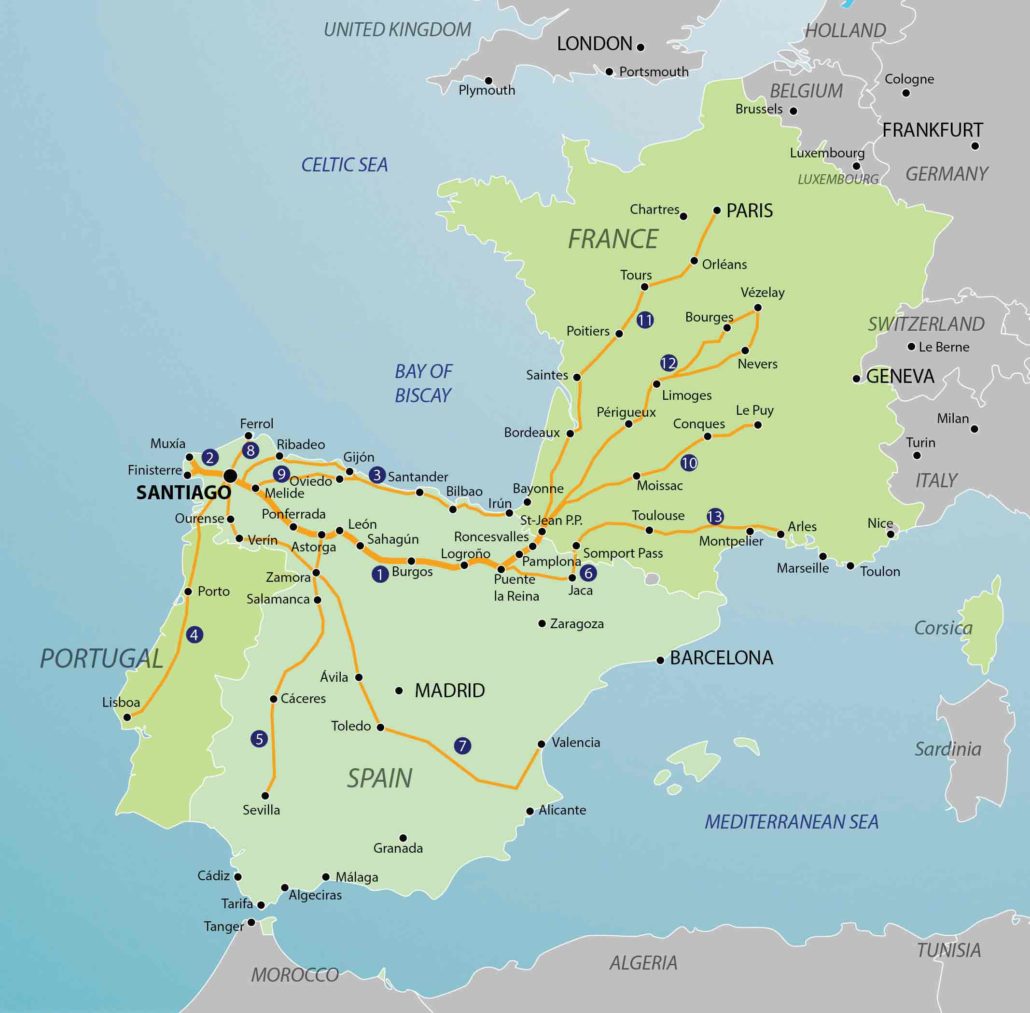The Many Ways to Santiago
When most people think of the Camino de Santiago, they usually are picturing the most popular route, the Camino Francés (the route featured in the Martin Sheen film The Way). However, there are many Caminos leading to Santiago!
In Medieval times, pilgrims simply left their front door and walked to Santiago, using whatever roads and paths were safest and most direct. While today the Francés route is the most developed, other Camino routes also offer a wonderful pilgrimage experience.
SPAIN and PORTUGAL
1) Camino Frances (800km, St-Jean-Pied-de-Port to Santiago)
2) Camino Finisterre (90km, Santiago to Finisterre and Muxia)
3) Camino del Norte (825km, Irún to Santiago)
4) Camino Portugués (610km, Lisboa to Santiago)
5) Vía de la Plata (1000km, Sevilla to Santiago)
6) Camino Aragonés (170km, Samport Pass to Puente la Reina)
7) Camino de Levante (1300km, Valencia to Santiago)
8) Camino Inglés (115km, Ferrol to Santiago)
9) Camino Primitivo (350km, Oviedo to Santiago)
FRANCE
10) Chemin de Le Puy (730km, Le Puy to St-Jean-Pied-de-Port)
11) Chemin de Paris (1000km, Paris to St-Jean-Pied-de-Port)
12) Chemin de Vézelay (900km, Vézelay to St-Jean-Pied-de-Port)
13) Chemin d’Arles (740km, Arles to Samport pass)
Many other connecting routes exist from various locations in Europe.
Choosing a Camino Route
With the many pilgrimage routes available in Spain, Portugal, and France, it can be overwhelming to choose which route is right for you. Here are a few questions to help guide your exploration:
- Do you want to walk with other people, or by yourself?
The Camino Francés route is very popular and you are guaranteed to walk with many others during the popular seasons. The Camino Portugués is also quite popular north of Porto. On other less frequented camino routes (Camino Portugués south of Porto, Camino del Norte, Camino Primitivo, Camino Inglés), you’ll still encounter other pilgrims, but you’re more likely to have time to yourself, walking alone throughout the day. On every route, the last 100km to Santiago can become crowded! - Do you want to stay in pilgrim accommodations (inexpensive hostels) or do you prefer to have private accommodations, or to camp?
The Camino Francés is the best set up for staying in inexpensive dormitory pilgrim accommodations each night, as there are many hostels and very frequent distances. The Camino Portugués, Camino del Norte, Camino Primitivo and Camino Inglés routes all have reasonably-spaced albergues; however, distances between albergues are greater in places than on the Francés, and some private accommodations may be necessary.Similarly, the style of albergue can be less formalized on routes other than the Francés. In Portugal, pilgrims have been known to stay in fire stations or share rooms in simple pensions; on the Camino del Norte, select municipal buildings or gyms are open to pilgrims during the high season (July/August); and on the Camino Primitivo, in Asturias, old schoolhouses have been repurposed as albergues. On all routes, in Galicia (where pilgrim traffic is heaviest), albergues are generally more frequently spaced and well organized.
The Norte and Primitivo routes are more remote and so better suited for camping than the Francés route.
- How much time do you have to walk? Is it important for you to reach Santiago? What aspect of the Camino are you most interested in (mountain scenery, good wine, camaraderie)?
View three itineraries of varying length to complete the Camino Francés (26 days, 31 days, 40 days).There are numerous Camino Portugués intineraries. Walk all the way from Lisboa (26 days); or start from Porto and continue to Santiago on the central, coastal, and/or spiritual routes for a manageable two-week journey.
Our Camino Primitivo itinerary is 13 days from Oviedo to Santiago. The mountainous terrain is not for the faint-of-heart; but fit walkers can manage this route in two weeks.
Consider walking from Irún to Santiago on one of our various Camino del Norte itineraries. Or, walk from Irún and connect to Oviedo from Villaviciosa for a rugged, but beautiful and historic, itinerary combining the Camino del Norte and Camino Primitivo.
If you only have time for a week of walking, take a look at our comfortable Camino Inglés itinerary (6 days).


